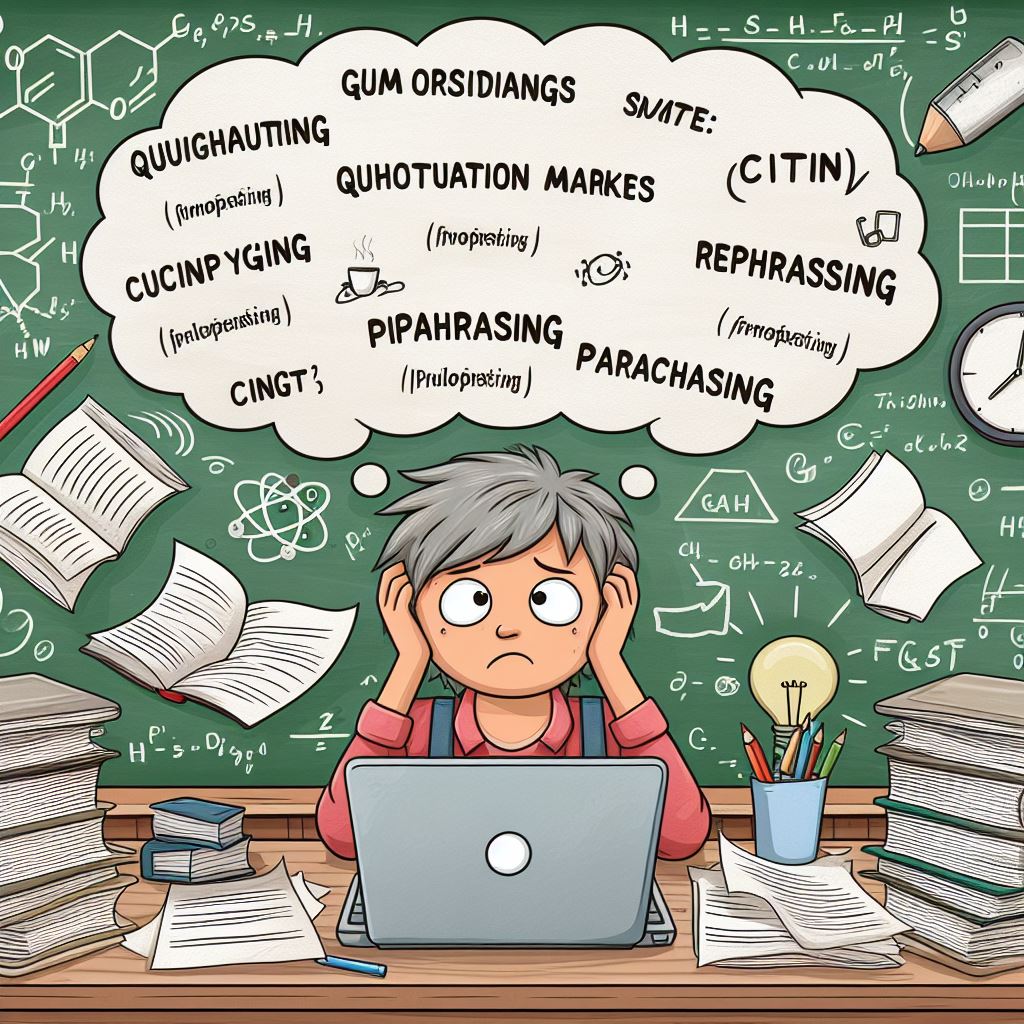How can I avoid plagiarizing?
Avoiding plagiarism involves a combination of awareness, knowledge, and meticulous citation practices. Familiarizing yourself with what constitutes plagiarism is crucial; it includes using someone else’s ideas, words, or work without proper acknowledgment. Understanding the significance of citing sources is equally pivotal; citations not only give credit to the original authors but also strengthen the credibility of your work. They showcase the depth of your research and support your arguments, thereby emphasizing the importance of academic honesty.

To steer clear of unintentional plagiarism, it’s essential to implement proper citation methods. Take the time to accurately document all sources you reference or quote in your paper, following the prescribed citation style. Keep meticulous notes during your research, noting down the necessary information about each source, such as the author’s name, publication title, page numbers, and publication date. This ensures you have the information required for a complete and accurate citation. Lastly, always double-check your citations to confirm they adhere to the citation style guidelines recommended by your instructor or academic institution. By integrating these practices into your writing process, you can uphold academic integrity and prevent instances of plagiarism.
Why do we cite?
Understanding the significance of proper citation practices is crucial in academic writing. Citations serve as a foundation for academic integrity, ensuring that the ideas presented in your work are properly attributed and contribute to the existing body of knowledge. Engaging with citations not only strengthens the credibility of your arguments but also fosters a deeper understanding of your subject matter. As you navigate the complexities of academic writing, comprehending the role of citations will empower you to present your ideas within the context of established scholarly conversations.
Connecting Ideas through Citations
Citations serve as the bridge linking your ideas with existing scholarly work within your field. By integrating citations into your writing, you establish a framework that showcases the interconnectedness of your thoughts with those of other scholars. These references validate and reinforce the arguments or claims you present, demonstrating that your ideas are rooted in established knowledge and research within the academic domain. Through well-integrated citations, you offer readers a comprehensive view of how your concepts align with, diverge from, or contribute to existing scholarly discourse.
Enhancing Credibility and Authority
Incorporating citations bolsters the credibility and authority of your writing. By acknowledging the works of other researchers or scholars, you showcase a thorough understanding of the subject matter and indicate that your assertions are substantiated by reputable sources. This validation not only reinforces the reliability of your arguments but also earns the trust and confidence of your readers. Citations add a layer of authenticity to your work, indicating that your ideas are part of a larger academic conversation and are supported by evidence-based research.
Facilitating Further Exploration
Citations serve as signposts that guide readers toward additional resources and deeper exploration. When you cite sources in your paper, you provide a roadmap for interested readers to delve deeper into the topics you discuss. These references allow readers to locate and access the original works, enabling them to explore the foundation of your ideas or conduct further research on related subjects. Through proper citations, you empower readers to engage with the broader body of knowledge within your field, encouraging intellectual curiosity and academic exploration.
When do I need to cite?
Understanding when to cite sources is crucial to maintain academic integrity and acknowledge the contributions of others in your work. Proper citation is necessary each time you utilize someone else’s words, ideas, or visual content in your writing. Whether you’re directly quoting or paraphrasing, attributing the original source is essential. When uncertain about whether to cite a particular piece of information, seeking advice from an online essay writing expert or your instructor is a prudent step. When time constraints hinder seeking immediate guidance, it’s better to err on the side of caution by providing citations than to risk unintentional plagiarism.
When to Use Citations
Citations are necessary whenever you employ someone else’s words, thoughts, or visual content in your work. Direct quotes require precise replication of the original words, enclosed in quotation marks, and attributed to the original author. Similarly, when paraphrasing or restating someone else’s ideas in your own words, proper credit to the original source is essential. If you’re uncertain whether a specific piece of information requires citation, seeking guidance from an online assignment help writer or your instructor is recommended. When in doubt, it’s safer and more ethical to cite than to omit citing altogether.
Importance of Quoting and Paraphrasing
Quoting verbatim from a source, encapsulated within quotation marks, is crucial when using exact phrasing from an author’s work. On the other hand, paraphrasing involves restructuring the author’s ideas into your own words while retaining the original meaning. In both cases, acknowledging the original authorship is imperative to uphold academic integrity.
Seeking Guidance and Resource Utilization
Consulting a professional essay writing help professional or your instructor for clarification on citation requirements is advisable if you’re unsure. Time constraints shouldn’t dissuade you from verifying proper citation practices. When pressed for time, erring on the side of caution by citing sources ensures academic integrity. Additionally, utilizing available resources like instructional videos on effective source integration and plagiarism avoidance can be immensely beneficial while crafting your writing.
How can plagiarism be avoided?
Avoiding plagiarism involves a multifaceted approach that requires a deep understanding of when and how to attribute sources accurately. It’s imperative to grasp the nuances of citing borrowed information, whether through direct quotes, paraphrasing, or summarizing, to maintain academic integrity. Mastery of citation techniques, coupled with diligent citation practices throughout the writing process, is pivotal in steering clear of unintentional plagiarism. Utilizing modern tools like citation management software can further streamline the citation process, ensuring precision and consistency in acknowledging sources. These concerted efforts empower writers to navigate the complexities of academic integrity confidently.
Understanding Citation Requirements
To navigate the fine line between original ideas and borrowed information, it’s essential to grasp when citation becomes necessary to avoid plagiarism. Whether you’re directly quoting, paraphrasing, or summarizing content from external sources, acknowledging the origin is critical. Drawing clear distinctions between your original thoughts and borrowed material is crucial to provide appropriate attribution, thus safeguarding your work from inadvertent plagiarism. Familiarizing yourself with the citation guidelines specific to your academic discipline ensures precision in acknowledging and crediting sources accurately.
Understanding these nuances of citation requirements empowers writers to uphold academic integrity by distinguishing between personal insights and information drawn from external sources. Recognizing when and how to cite information not only fortifies the credibility of your work but also demonstrates respect for the intellectual contributions of others.
Mastering Effective Quoting, Paraphrasing, and Summarizing
Mastering the art of effective quoting, paraphrasing, and summarizing is fundamental to academic writing. These techniques allow for the incorporation of external sources while preserving originality. Paraphrasing demands the rephrasing of information in a manner that reflects personal understanding while retaining the essence of the original content. Summarizing involves condensing extensive information into concise yet comprehensive forms, capturing the primary concepts without losing their integrity. Quoting requires a precise replication of the author’s words, encapsulating the essence of the original text within quotation marks and citing it appropriately.
Learning these techniques not only enables the integration of external information but also ensures the preservation of original thought. Skillful implementation of these strategies empowers writers to enrich their arguments with diverse perspectives while maintaining academic integrity through proper attribution of sources.
Avoiding Direct Copying
Fostering an active engagement with source material is paramount to circumvent the pitfalls of direct copying. Rather than succumbing to the ease of copy-pasting, take a proactive approach by immersing yourself in the content. Reading and comprehending the material equips you to internalize the information and articulate it in your own voice. Avoid the temptation to replicate sentences verbatim; instead, strive to express the essence of the material using your unique phrasing and understanding.
For better assimilation and to prevent unintentional copying, consider alternative methods. Typing out or transcribing quotes manually and printing sources can enhance your interaction with the information. These practices reinforce comprehension and encourage the formulation of original expressions, reducing the likelihood of inadvertently reproducing text without proper attribution.
Citing Throughout the Writing Process
Integrating citation practices into your writing process right from the start is crucial to sidestep the pitfalls of delayed citation. Rather than waiting until the end of the writing process, make citing a concurrent step as you infuse information from external sources. Adopting this proactive approach ensures that each piece of information is appropriately credited as it’s included, mitigating the risk of inadvertently omitting citations or misattributing sources in the final draft.
This immediate citation strategy not only streamlines the writing workflow but also fosters accuracy and consistency. It enables you to maintain a clear record of the sources utilized, facilitating ease in cross-referencing and verification during the writing process. By adhering to this practice, you uphold academic integrity and substantially reduce the chances of unintentional plagiarism, ensuring that every borrowed idea or quote is properly attributed in real-time.
Utilizing Citation Management Tools
Employing citation management software can significantly expedite and systematize the citation process, providing an organized approach to handling references. Tools like EndNote or other similar software offer comprehensive platforms to collect, manage, and seamlessly integrate citations into your writing. They streamline the storage of bibliographic information, allowing you to gather and catalog sources efficiently.
By utilizing citation management software, you gain access to an extensive database where you can maintain a repository of collected sources. These tools often facilitate automatic formatting of citations according to specific citation styles, ensuring consistency and accuracy throughout your document. Embracing such technology not only simplifies the citation process but also minimizes the margin for error, empowering you to focus more on crafting your arguments while the software efficiently handles the referencing aspect of your work.
Would you like more details on any specific aspect of plagiarism avoidance or citation practices?
What can the Assignmenthelp.net do to help?
Understanding proper citation methods and avoiding plagiarism are crucial aspects of academic writing. Our assignment helpers and essay writers offer a range of resources and assistance to help writers navigate the complexities of citing sources accurately and ethically. Through expert guidance, access to official citation handbooks, and support in mastering quoting, paraphrasing, and summarizing techniques, writers can confidently navigate the intricacies of citation systems and ensure the integrity of their academic work.
Understanding Citation Systems
Online Essay writing help experts at the Assignmenthelp.net provide comprehensive guidance on specific citation styles like MLA, APA, and Chicago. They offer explanations and assistance in comprehending the intricacies of each citation system. Whether it’s understanding the formatting guidelines, in-text citations, or bibliography entries, consultants help clarify the nuances of these citation styles, ensuring accuracy in attributing sources.
Effective Quoting, Paraphrasing, and Summarizing
Our consultants offer practical strategies and tips for effective quoting, paraphrasing, and summarizing to integrate source materials seamlessly into your writing. They guide you through the techniques of using quotations sparingly, rephrasing information in your own words, and condensing source content while retaining its essence. By honing these skills, writers can avoid plagiarism and create well-integrated, original content.
Access to Official Handbooks
Assignmenthelp.net also provides access to official handbooks for major citation systems such as MLA, APA, and Chicago. Consultants assist in utilizing these resources effectively, demonstrating how to navigate through these guides for accurate and consistent citation formatting. Access to these handbooks empowers writers to refer to authoritative sources for specific citation rules and examples while ensuring adherence to the prescribed formatting guidelines.


